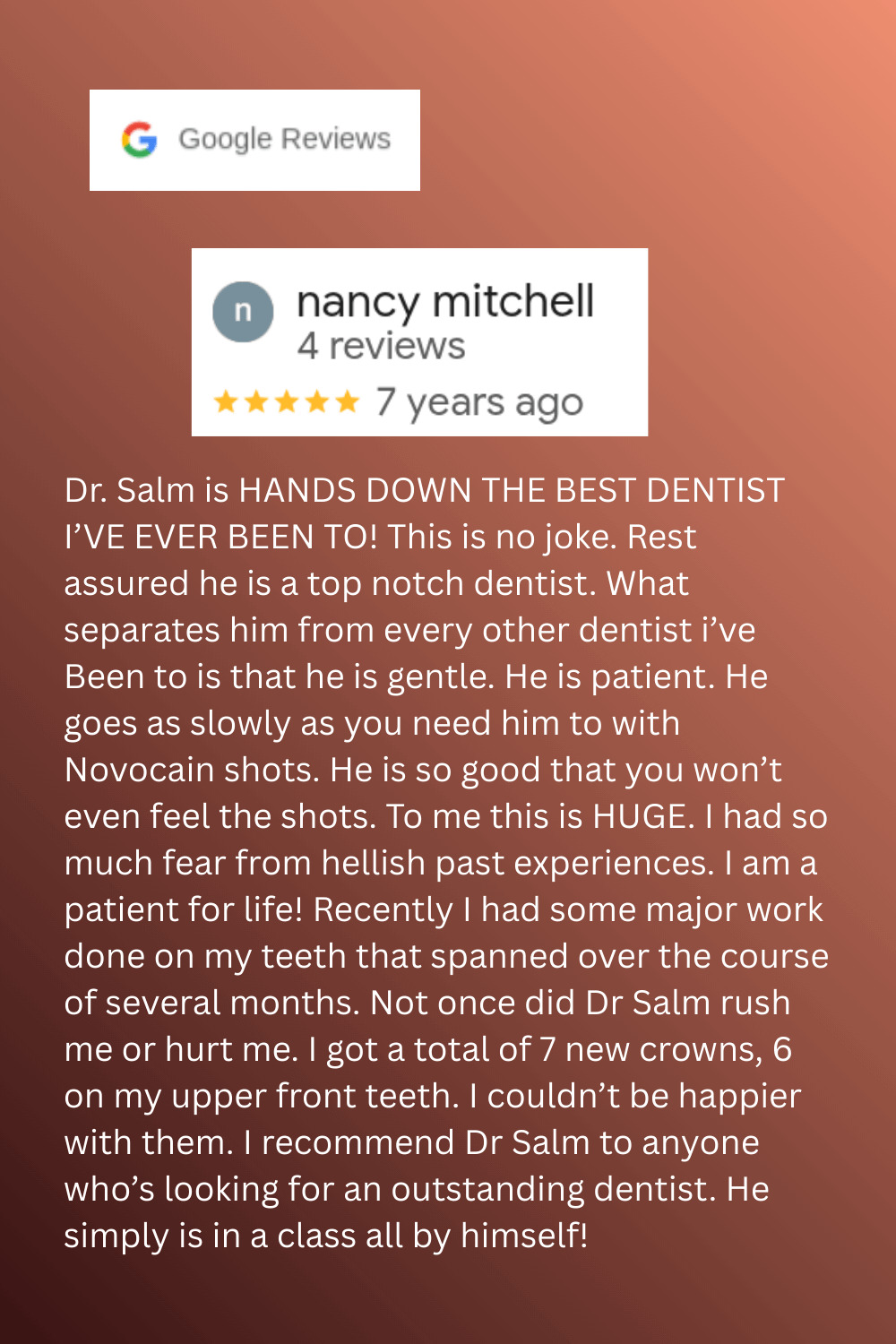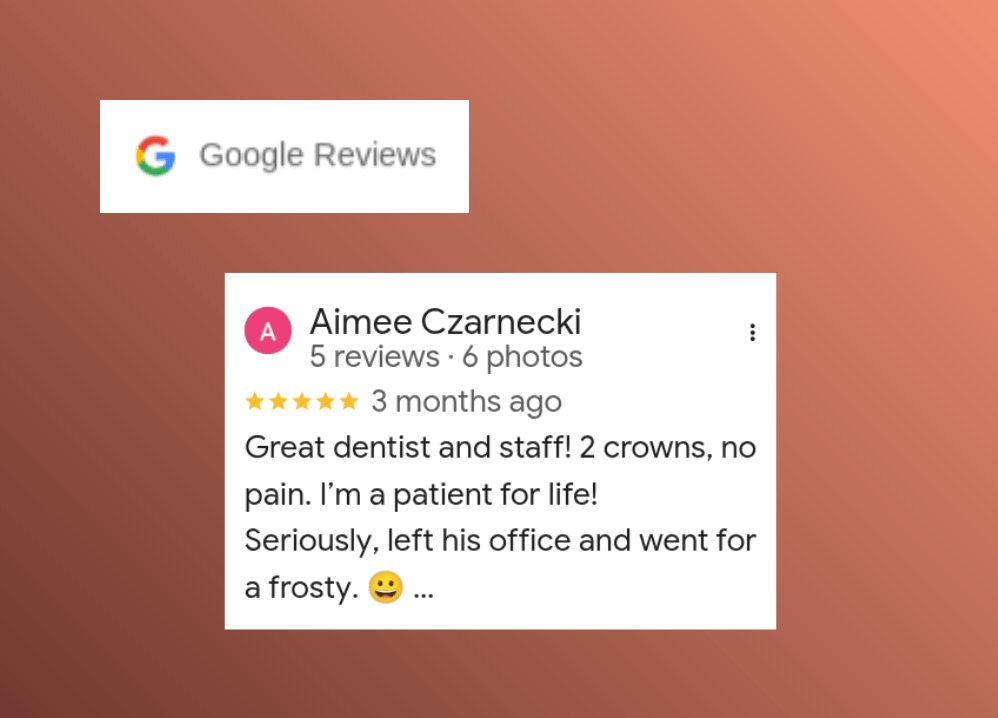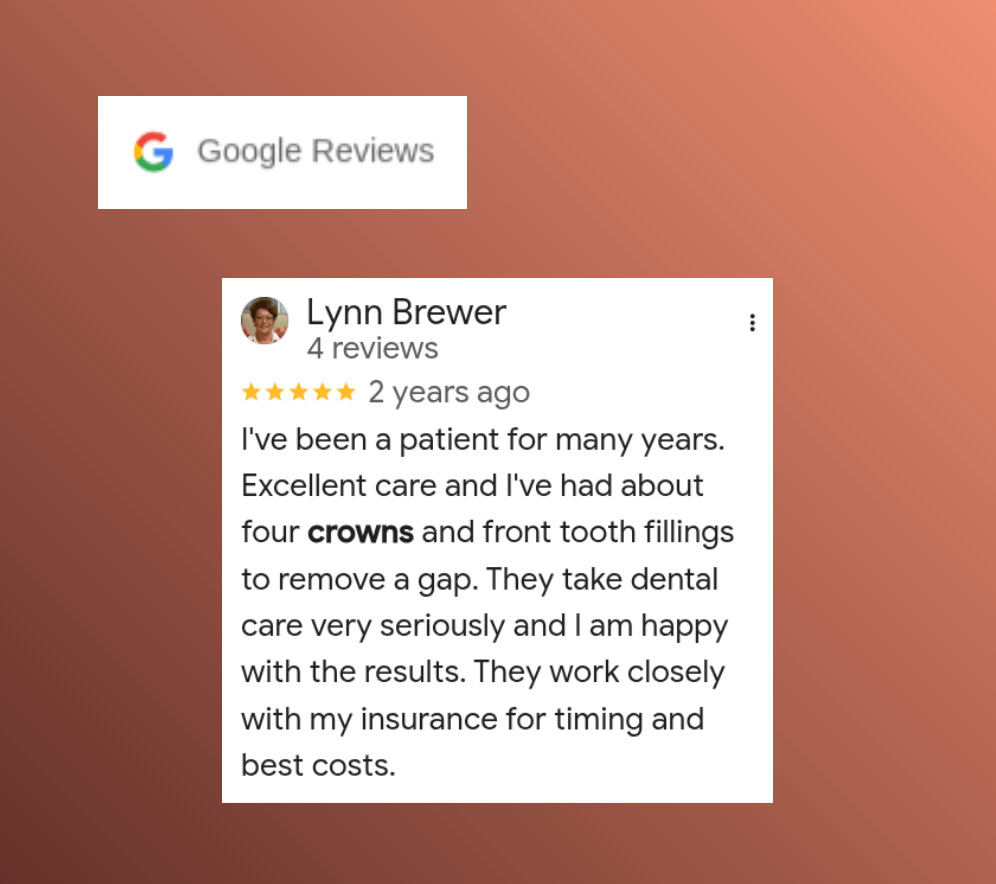Do you have a damaged or decayed tooth that needs a permanent crown? Have you heard about the CEREC® technology to create and place custom dental crowns in a single appointment?
Traditional crowns require multiple visits, temporary restorations, and weeks of waiting. But with CEREC crowns you can restore the strength, function, and appearance of your tooth in just a few hours.
Why wait or deal with tooth loss or temporary crowns if you can get your new crown right away?
Delaying crown placement on a damaged tooth can result in further decay or infection, which can contribute to bone loss around the affected tooth area.
Why risk losing that tooth and needing an implant, crowns and bridges, or partial dentures when we can take care of it today?
What Are Same-Day Dental Crowns?
Same day crowns are extremely durable, custom-made restorations crafted with CAD/CAM (computer-aided design and manufacturing) technology.
Using digital scans of your teeth, Smiles for Miles Dentistry’s Dr. Richard Salm designs and mills your ceramic crown right here in our Brookfield dental office, located only 7-8 miles from downtown Waukesha, Wisconsin.)
This eliminates the need for messy impressions, dental labs, or temporary crown placement. These new crowns are suitable for back teeth and all other teeth that aren’t too damaged.
CEREC® CAD CAM Technology Explained
CEREC® CAD/CAM technology is a cutting-edge dental system that uses computer-aided design (CAD) and computer-aided manufacturing (CAM) to create dental restorations such as crowns, veneers, inlays, onlays, and bridges in a single visit.
CEREC is an abbreviation for Chairside Economical Restoration of Esthetic Ceramics. CEREC CAD/CAM technology revolutionizes restorative dentistry by integrating digital scanning, precise computer design, and in-office milling.
This dental crown procedure delivers durable, aesthetic dental restorations in a single visit, making the dental treatment process faster, more comfortable, and highly accurate.
How The CEREC Dental Crown Procedure Works
Here are the steps of the dental crown procedure:
- Tooth Preparation – The damaged or decayed portion of the affected tooth is removed, and the tooth is shaped to support a crown.
- Digital Impressions – A 3D scan captures precise details of your existing tooth—no messy impression material or trays required.
- Design – Using advanced software, Dr. Salm designs a permanent crown that matches your natural teeth. This process ensures your crown fits perfectly!
- Milling – Our in-office CEREC milling machine carves your crown from high-quality ceramic in about an hour. There is no need to wait for a specialized dental laboratory to create your new crown.
- Placement – Once polished and fitted, the crown is bonded securely to your prepared tooth with strong dental cement.
- Quality – Your new dental crowns are carefully crafted to perfectly work with the opposing teeth to ensure every crown fits and matches the bite so chewing is efficient and comfortable.
Benefits Of One Appointment Crowns
The primary benefit is that you only have to visit your dentist’s office once. Dental crowns provide many benefits related to maintaining your oral health:
- Convenience – Complete your crown in one visit, no need for temporary crowns.
- Durability – Made of strong, long-lasting ceramic materials.
- Natural Appearance – Custom shade-matching ensures your crown blends seamlessly with your other teeth.
- Comfort – No uncomfortable impressions or multiple appointments.
- Preservation – More of your natural tooth structure is saved compared to traditional methods.
- Protection – Dental crowns cover the entire surface of your decayed tooth providing excellent protection.
- Avoid Partial Dentures – By preserving your existing tooth structure, placing crowns as soon as they’re needed can delay the need for bridges and partial dentures.
How to Care For Your CEREC Crown
With proper care, your crown can last ten to fifteen years or more. To protect it:
- Brush twice daily and floss around the crown as you would your natural teeth.
- Avoid chewing on hard foods, ice, and objects like pens.
- Limit staining foods and drinks such as coffee, wine, tea, and soda.
- Wear a nightguard if you grind your teeth.
- Visit our dental clinic regularly for checkups and cleanings to maintain good oral hygiene.
Are Crowns the Same as Dental Caps?
A crown is the same as an artificial cap. The terms are used interchangeably, with “dental cap” being a more informal or older term, while “dental crown” is the formal term used by dental professionals.
Both crowns and caps are tooth-shaped covers placed over an existing tooth to restore its shape, size, strength, and appearance.
What if I Have Missing Teeth?
Dental professionals like our own Dr. Salm offer many treatment options to replace missing teeth. A crown alone doesn’t replace a missing tooth.
However, permanent crowns and bridges used together are one option. Dental crowns serve as anchors between dental bridges.
Dental implants are the other commonly used treatment plan to replace missing teeth.
When is a Crown Needed versus Conventional Fillings?
Fillings are used when the decayed tooth has minor to moderate cavities or small chips. For a more extensively decayed tooth or cracked teeth, a dental crown is necessary.
Multiple factors indicate a tooth may need a dental crown:
- More than half of the chewing surface is affected.
- The tooth is severely worn or misshapen.
- After a root canal.
- Crowns are often used for cosmetic reasons.
Your dental professional can guide you in the optimum treatment plan for any dental condition. Discuss whether you need a filling versus a crown with your dentist.
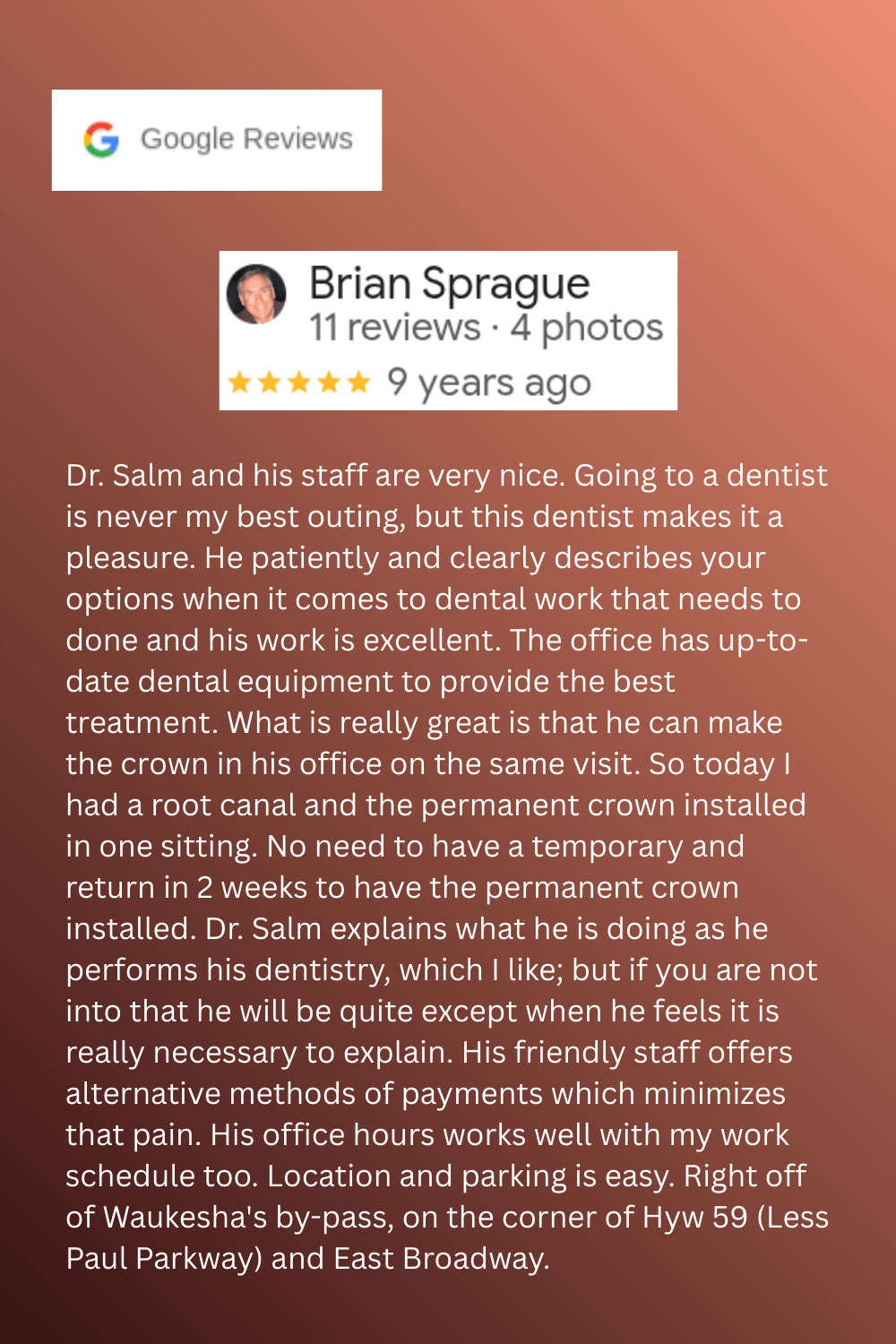
When Are Both Crowns and Bridges Needed?
Dental technicians use a crown to cover a decayed tooth. It is one of the most common of the restorative treatments for weak teeth. Dental crowns cover the entire tooth above the gums.
However, if you have missing teeth you need more than a crown. A common solution is to use crowns to support both sides of dental bridge.
Crowns and bridges are used together to replace missing teeth. Bridges cost less upfront than implants and are more likely covered by dental insurance, making them more accessible for some patients.
What Materials Are Used in CEREC Dental Crowns?
CEREC dental crowns are primarily made from high-quality ceramic materials using advanced CAD/CAM technology.
Dr. Salm shared what he recommends to patients at Smiles for Miles:
“I use a good amount of zirconia, as the cosmetics have improved immensely and it is the strongest ceramic available today.
And i also use lithium disilicate. For both materials, when needed, we utilize Miyo custom staining, in-office, to achieve the best shade matching possible.”
Common Materials Used in CEREC Crowns
Various materials are used for dental crowns in general and CEREC crowns in particular. These are the most common choices when placing CEREC crowns:
Lithium Disilicate (E.max):
A popular all-ceramic material known for its excellent strength, durability, and natural translucency, making it suitable for both front and back teeth. E.max crowns bond securely to natural teeth and typically last 10–15 years with proper care.
Zirconia:
Zirconium dioxide is highly durable and biocompatible, ideal for back teeth that endure heavy chewing forces. Zirconia crowns resist wear, chipping, and fractures and also offer good aesthetics.
Feldspathic Ceramic:
This material mimics the appearance of natural enamel closely and is used for lower-stress areas requiring superior aesthetics. It tends to be more fragile than lithium disilicate or zirconia.
Other Materials
Some CEREC crowns may incorporate porcelain fused to metal (PFM), although this is less common in same-day crowns where all-ceramic crowns dominate due to aesthetics and biocompatibility.
Here’s a comprehensive chart showing a comparison of CEREC dental crown materials:
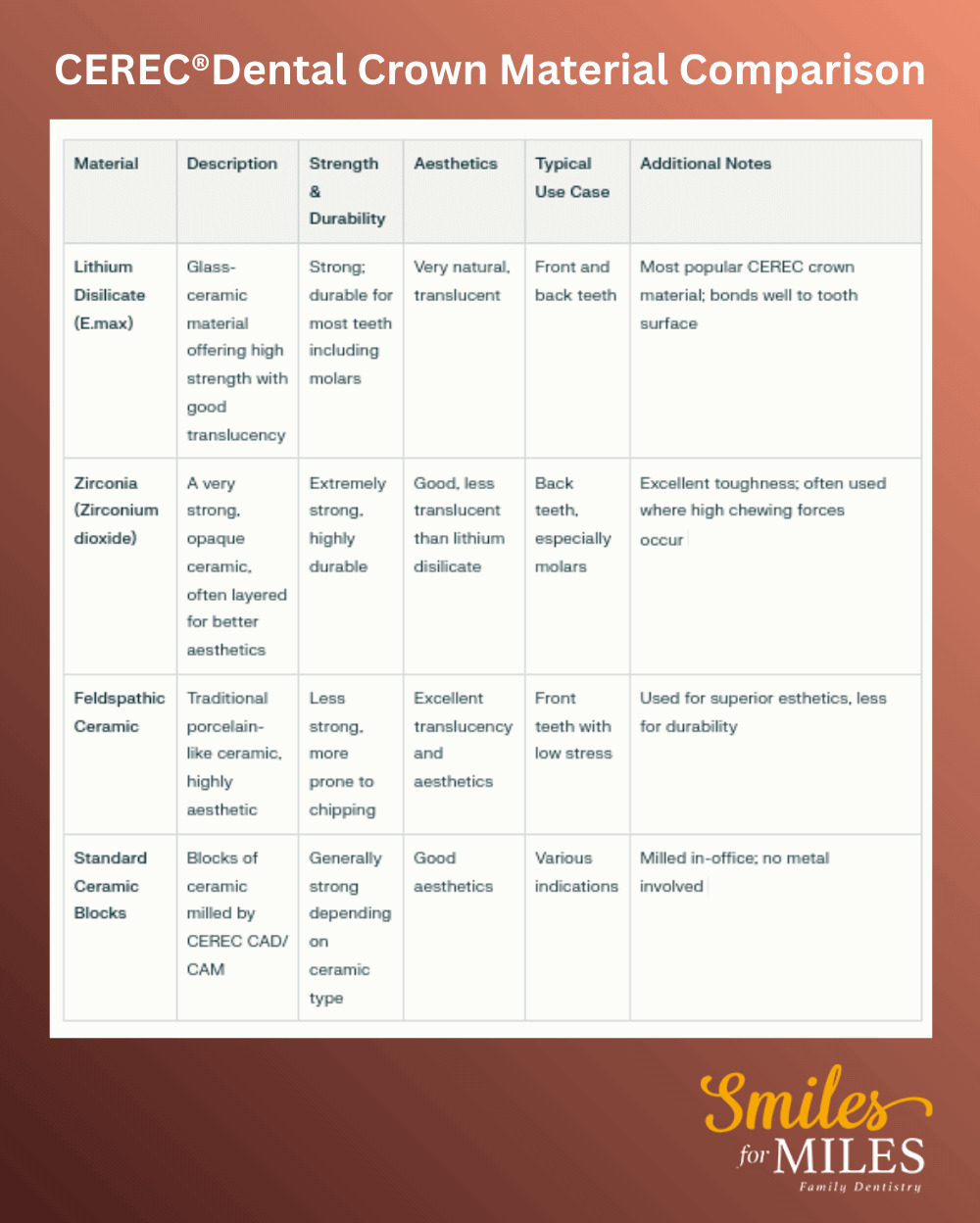
Advantages of These Materials in CEREC Crowns
They offer excellent strength, longevity, and natural appearance, blending seamlessly with surrounding teeth. The digital design and milling process allows for precise fit and fast, one-visit delivery without temporary crowns.
The materials are metal-free, reducing the risk of allergic reactions and darker gum lines common with metal-based crowns.
In summary, CEREC crowns use advanced ceramic materials like lithium disilicate (E.max), zirconia, and feldspathic ceramic because they provide durable, natural-looking, and biocompatible restorations crafted in a single dental appointment.
Materials Used in Multi-appointment Metal Crowns
Not all materials used in traditional, multi-appointment dental crowns are suitable for the CEREC process. However, both methods use porcelain or ceramic materials for the crowns.
The multiple visit dental crown procedures can also use various metal, metal-ceramic, or gold alloy for dental crown procedures.
Here is a detailed dental crown material comparison:
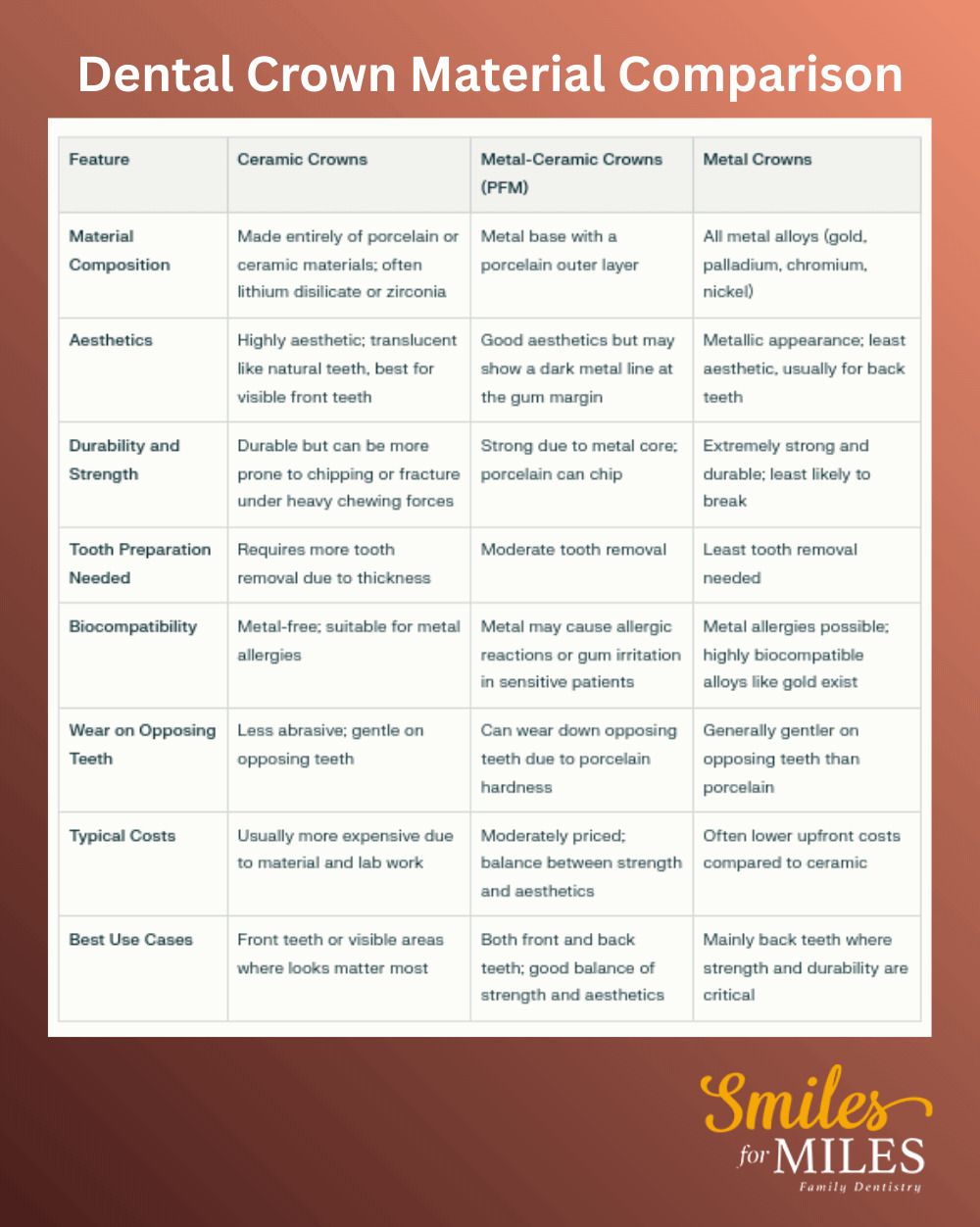
Are Dental Implants Better than Dental Bridges?
Dental bridges cost less upfront than dental implants and are more likely to be covered by dental insurance. This makes them more accessible for some patients.
Ask your dental professional to determine what is best for you based on your oral health goals and budget. Dental implants can be cost effective over a more long-term treatment plan.
Crowns Versus Veneers? Which Do I Need?
Veneers cover only the front surface of a tooth. They aren’t protective of a decayed tooth. Your dental professional can determine whether veneers can be used on a damaged tooth or it needs a crown.
Ceramic Crowns, Metal Ceramic Crowns, or Metal Crowns?
Ceramic crowns offer the best aesthetics and biocompatibility, but at a higher cost. They are more vulnerable to chipping than metal or metal-ceramic crowns.
Metal-ceramic crowns (PFM) provide a good compromise of strength and looks but may show a dark line at the gums and have allergy concerns.
Metal crowns excel in durability and conservatism of tooth structure but lack natural appearance. They are best used for molars during a multi-appointment dental crown procedure.
Zirconia crowns are the strongest material used for molars created using the CEREC one-appointment process. Here is an image comparing the best materials for molar dental crowns:
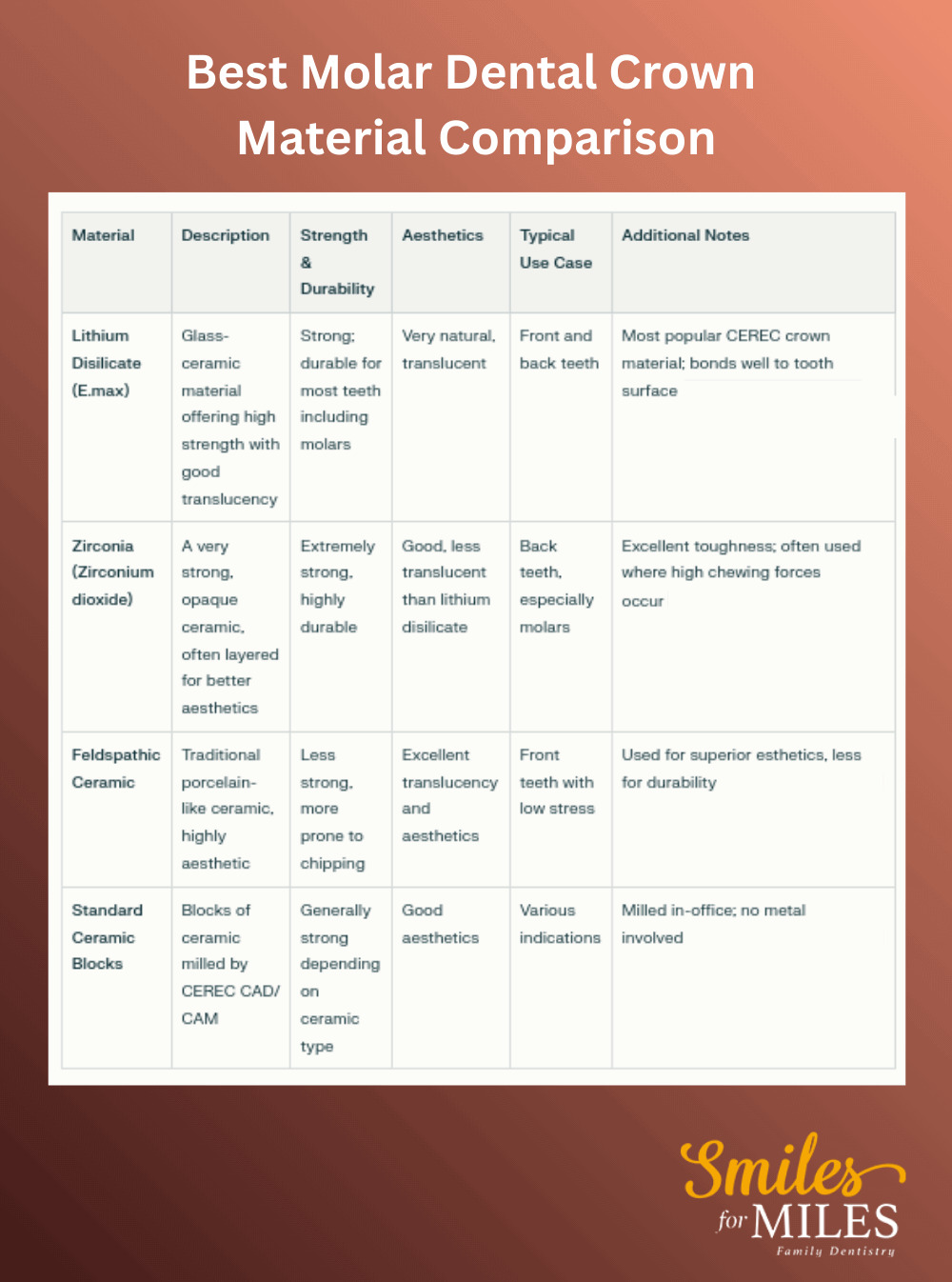
Frequently Asked Questions
Are Dental Crowns Painful?
The dental crown procedure is done under local anesthesia. Most patients experience only slight pressure and no pain.
How Long Do CEREC Crowns Last?
With proper oral hygiene and care, these crowns can last 10–15 years and sometimes 20-30 years with excellent care.
Are Same-day Crowns as Strong as Traditional Crowns?
Yes. CEREC crowns are made from durable ceramic designed to withstand daily use. Refer to our crown materials comparison images in the above content for details.
How Do I Care for My Dental Crown?
Use the same good oral hygiene you use on your regular teeth. And visit your dentist regularly! Failure to properly clean around your dental crowns could lead to gum disease.
Will My Insurance Cover a Same-day Crown?
Most dental insurance plans cover crowns, but coverage varies. Our team will help review your benefits.
Will a Crown Improve My Dental Health?
Crowns protect weakened, damaged or decayed teeth to prevent further decay, cracks, and fractures. They support adjacent teeth and stabilize your bite. Crowns can also be used to anchor dental implants and bridges.
Are There Any Possible Complications?
While placing dental crowns is usually straightforward, there are some common complications:
- If not enough tooth surface is visible above the gums, crown lengthening (sometimes referred to as tooth lengthening) may be necessary.
- Allergic reactions are possible, but more likely with metal dental crowns than ceramic materials.
- If the affected tooth is a weak tooth, it may require a root canal procedure.
Why Do Many Dentists Not Use CEREC Technology?
Not all dental offices have the advanced equipment required for the CEREC dental crown procedure. Without it, dental offices have to use temporary crowns and wait for a dental laboratory to create a permanent crown.
So if you don’t want to wait, you’ll want to make your appointment to get dental crowns with a dental professional who has the CEREC equipment.
We’d love to assist you with an immediate dental crown procedure.
Schedule Your CEREC Crown Appointment
Don’t wait weeks to restore your complete smile. With advanced CEREC technology, Smiles for Miles Family Dentistry offers same-day crowns that are convenient, comfortable, and natural-looking.
Why wait for a dental lab when you can repair a damaged tooth today? Call us at (262) 548-3555 or request your appointment online to see if you’re a candidate.

